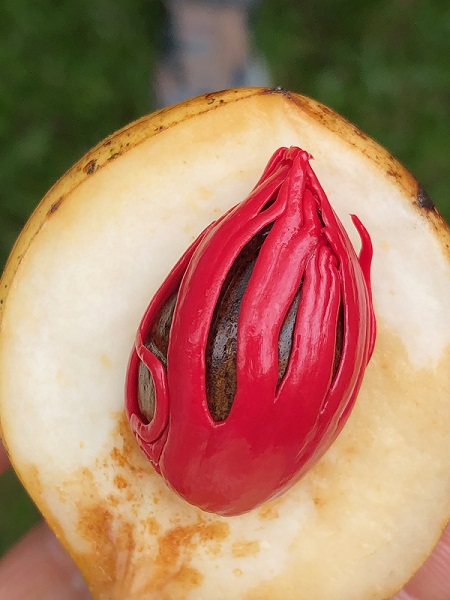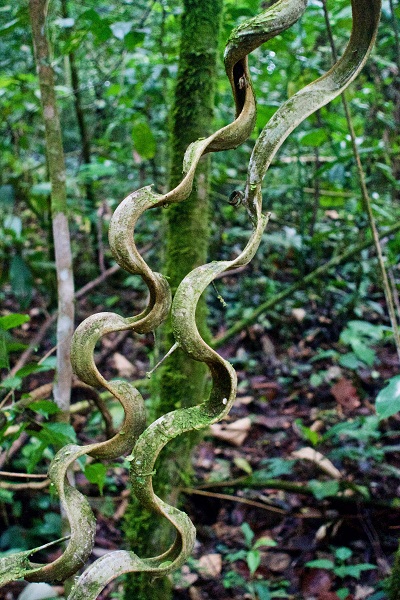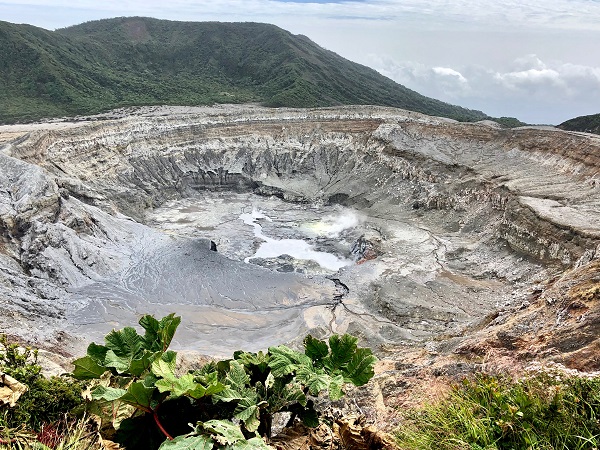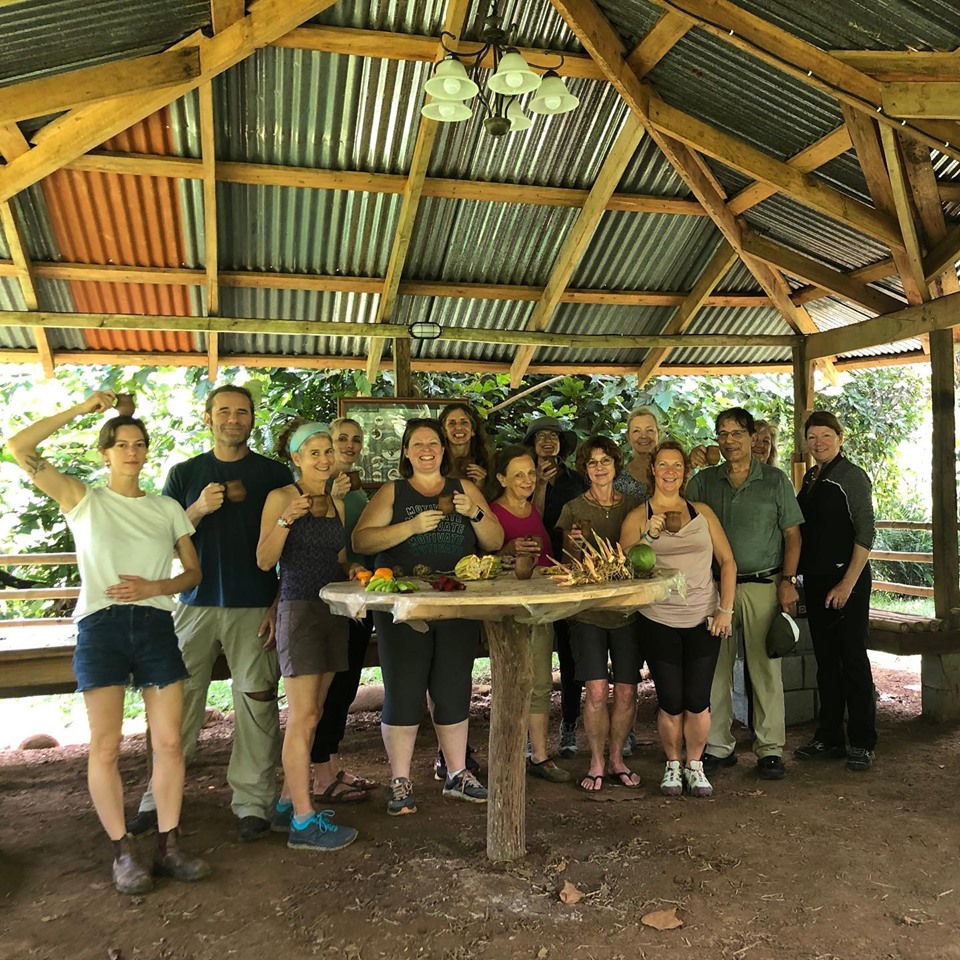Our second trip to lush Costa Rica proved just as magical as our first in September 2018. This time a wonderful group of 12 folks joined us to explore several areas of Costa Rica.
We began our tour at Finca Luna Nueva (in the region of San Carlos), the second biodynamic farm established in Costa Rica where they used to grow organic ginger and turmeric for New Chapter before Procter and Gamble bought it out. One of the farm’s
co-owners, Steven Farrell, started us off with a farm tour of 320 species of tropical medicinal plants of diverse biological categories – trees, shrubs, grasses, and lianas (woody climbing plants).
Amongst many of these plants, we saw acerola berry (from the cherry tree), hombre de grande (Quassia amara, one of the ‘spices’ used in commercial bitters), allspice, katuk (a sweet leaf used in Indonesian cooking), annatto (of course a few of us couldn’t resist
dying our lips with its red powder), nutmeg (we cracked its pod open to inspect the red mace covering its seed), the tea plant, and many varieties of ginger, turmeric and galangal.

Mace around nutmeg seed
We learned that at Luna, they harvest bark from the Cinnamomum verum tree by growing it for seven years and then cutting the trunk to within a few feet of the ground. This allows suckers to grow that are then used over time instead of killing the tree.
From there we explored Luna’s local forest with of one Costa Rica’s two prominent ethnobotanists, Raffa Ocampo. He enthusiastically introduced us to the uses of many plants, including:
- The beautiful undulating monkey’s ladder liana (Bauhinia – for back pain, parasites and diarrhea)
- Gavilana (Neurolaena lobata – used for parasites and digestive disorders; in Jackass Bitters)
- sour cane (Costus spicatus – tonifying, antiseptic and diuretic; often combined there with corn silk and passion flower),
- sour orange (Citrus aurantium, also called bitter orange or zhi shi by the Chinese, who use the peel; in Costa Rica they use the leaf as a sedative and digestive aid)
- stevia (used not just as a sweetener but also for bronchial and intestinal problems)
- uña de gato (Uncaria tormentosa or cat’s claw – they use the bark and root of this liana for arthritis and digestive disorders; it reminded us of Uncaria rhynchophylla, gou teng, the stem and spine – ‘claw’ – used in Chinese medicine for spasms, hypertension and headaches)

Monkey’s ladder
We saw many more plants of course, but Raffa’s discussion was most interesting. He confirmed that the indigenous folk dosed themselves similarly to those in the US by stuffing a pot full of herbs and water, cooking them down and then drinking large
quantities of this tea until it worked!
As well, both Steven and Raffa discussed the importance of secondary metabolites in herbs – their important healing properties. One of the key principles to these is that if the plant is grown outside its native habitat, its secondary metabolites are lost, rendering the plant less effective. Pharmaceutical companies don’t care about these, but herbalists do. This indicates that monoculture isn’t as effective since environment matters, and not just the soil, but also the area’s biodiversity. The Chinese have long recognized this, stating how important it is to harvest plants grown in their particular locations.
The next day we experienced a fabulous cacao “tour” where we learned the entire gamut of making chocolate from seeing the pod on the tree and breaking it open to eating the sweet fruit around its seeds, and grinding the fermented and toasted beans into a mash. We ate some of this raw and added 30% sugar to the rest, making our own huge chocolate bar that we broke into pieces and enjoyed the remainder of our trip. It was the most delicious chocolate any of us had ever eaten, partly because the cacao oil
was retained rather than siphoned off to make the second cacao butter product good for the skin, as is done with most commercial cacao (typically palm oil is added back in instead).

Shelling cacao
The next day we traveled to beautiful Amatierra yoga and healing retreat center (one hour southwest of the San Jose airport), owned and run by Jill and Bob Ruttenberg for 13 years. There, Quitirrise Medicine Woman, Doña Zoraida, joined Jill to lead our group on a mountain forest herb tour. Zoraida not only discussed the herbs and their local uses but also shared how they were employed in native ceremonies for healing.
Scattered amongst all these fabulous herb explorations were adventures to local sites. We again visited Arenal volcano with its forest, farm and gardens as well as soaked in the nearby hot springs, the most beautiful many had ever seen. On yet another day, half the group explored the beach while the others visited Poas volcano (the last eruption as in April, 2017!) and the La Paz garden waterfall cascades, complete with indigenous rescue insects, butterflies and animals of all sorts.

Poas Volcano crater
As well, Michael, Jill and I gave scheduled and impromptu classes, including Korean Hand Therapy, pulse diagnosis, Kampo abdominal diagnosis and herbal therapy, and Chi Nei Tsang self-help abdominal massage along with other spontaneous teachings. Needless to say, it was a very full adventurous week that also found us drifting in swimming pools, receiving massages, reading, communing with others, and more relaxing activities. Our week together was truly a healing retreat on all levels, leaving many of us wanting more. In fact, a new style of East West retreat may well have been born – we might schedule other such traveling retreats for personal study and healing in the future.

Lesley with “poor man’s umbrella” plant

